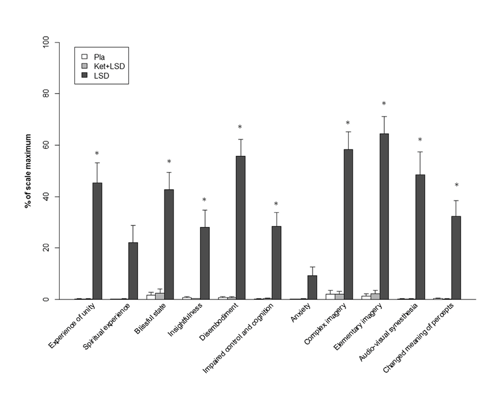A study appearing in has finally revealed the main mechanism by which LSD exerts its effects on the human brain. In this 150 Second analysis, ��ѻ��ý clinical reviewer F. Perry Wilson, MD, highlights the methodology, and explains why that really meaningful conversation you had in college really wasn't.
Lysergic acid diethylamide. LSD. It is the prototypical, if not the original, psychedelic drug. Despite its first being synthesized in 1938, we still are not entirely clear on its mechanism of action. But a well-conducted randomized trial, now makes it clear that a surprising amount of the effects of LSD are mediated through the serotonin 2A receptor in the brain.

Before we get into the details, and explore why I never get invited to participate in trials like this, let me set the stage by noting that LSD is an agonist at many serotonin and dopaminergic receptors in the brain. And LSD has multiple effects. There's the sensory effects – synesthesia, hallucination. There's the euphoria. But LSD, and several other drugs including marijuana, also stimulate brain centers that attach meaning to external stimuli. Remember when you were smoking pot in college and had that amazing conversation that was so meaningful? Yeah, it probably wasn't.
But I've always thought this is what makes some of these drugs attractive – they make our mundane existence seem more important.
The hypothesis is that all of these diverse effects would be mediated by diverse receptors in the brain. But this study found just the opposite. Nearly all of LSDs effects operated through one receptor.
Researchers took 21 volunteers in a double-blind, randomized, cross-over design, and exposed each of them to three conditions. Placebo, LSD – 100 micrograms which is a decent, but not crazy dose, or LSD plus an antagonist to the serotonin 2a receptor called ketanserin.
If you look at figure 1, you can see that the serotonin 2A blocker basically negated all the effects of LSD:

The black bars are the effects of LSD alone. Note the high levels for "feelings of unity," "blissful state," "disembodiment." The other bars are the other two conditions – basically no effects across the board.
What about meaning? This was clever. Each participant chose six songs that were particularly meaningful for them. During the study, they were exposed to those songs, and others that were neutral or meaningless. They then rated their meaning.

The meaningful songs stayed meaningful with or without LSD. But the meaningless songs got much higher scores when the participants were on the drug.
This is really important because one theory of psychotic disorders states that it is a misapplication of meaning to meaningless stimuli that lead to things like delusions. The TV is not really talking to you, but you feel there is meaning there. And indeed, many of the atypical antipsychotics are serotonin 2A receptor blockers.
Some people think taking beautiful or spiritual experiences and distilling them into brain chemistry takes away their importance. To me, there are few things more fascinating. The world is the world, but it is our perception of it that is the real acid test.
, is an assistant professor of medicine at the Yale School of Medicine. He earned his BA from Harvard University, graduating with honors with a degree in biochemistry. He then attended Columbia College of Physicians and Surgeons in New York City. From there he moved to Philadelphia to complete his internal medicine residency and nephrology fellowship at the Hospital of the University of Pennsylvania. During his post graduate years, he also obtained a Master of Science in Clinical Epidemiology from the University of Pennsylvania. He is an accomplished author of many scientific articles and holds several NIH grants. He is a ��ѻ��ý reviewer, and in addition to his video analyses, he authors a blog, . You can follow .
